
Cattleya is a genus of orchids from Costa Rica south to Argentina. The genus is abbreviated C in trade journals.
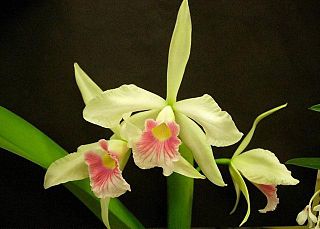
Cattleya purpurata, known in the past as Laelia purpurata and Sophronitis purpurata, is native to Brazil where it is very popular among orchid growers. It is an epiphyte that is found in the canopy of tall trees near coastal areas, in the Brazilian states of Rio Grande do Sul, Santa Catarina and São Paulo. The orchid favors bright light and cool to warm conditions and is relative easy to cultive. C. purpurata has been used extensively as a parent in hybridizing with Cattleyas. Cattleya purpurata blooms from late spring to fall with three to five flowers on a spike. The flowers are long-lasting and fragrant.

Cattleya trianae, also known as Flor de Mayo or "Christmas orchid", is a plant of the family Orchidaceae. It grows as an epiphytic orchid, with succulent leaves, endemic to Colombia where it was nominated as the national flower in November 1936. That year, the National Academy of History of Argentina asked the Latin American countries to participate in an exhibition with the representative flowers of each country. The Colombian government gave the botanist Emilio Robledo the task to designate the most representative flowering plant of the country.
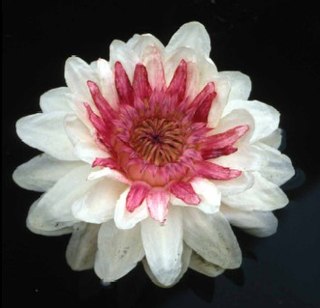
The Flora of Colombia is characterized by over 32,000 species of green plants.
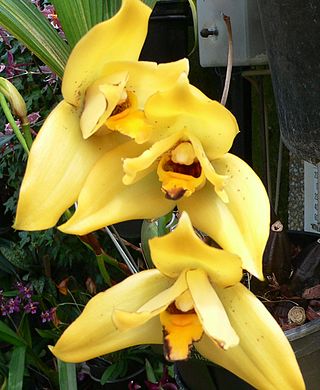
The term grex, derived from the Latin noun grex, gregis, meaning 'flock', has been expanded in botanical nomenclature to describe hybrids of orchids, based solely on their parentage. Grex names are one of the three categories of plant names governed by the International Code of Nomenclature for Cultivated Plants; within a grex the cultivar group category can be used to refer to plants by their shared characteristics, and individual orchid plants can be selected and named as cultivars.

Cattleya dowiana is a species of orchid. The diploid chromosome number of C. dowiana has been determined as 2n = 40; the haploid chromosome number has been determined as n = 20.

Cattleya granulosa is a bifoliate Cattleya species of orchid. It is endemic to Brazil; the type specimen was reported to come from Guatemala, but this is likely erroneous. The diploid chromosome number of C. granulosa has been determined as 2n = 40.

Cattleya intermedia, the intermediate cattleya, is a bifoliate Cattleya species of orchid. The diploid chromosome number of C. intermedia has been determined as 2n = 40.
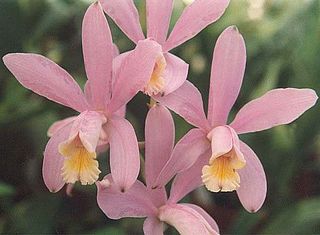
Cattleya loddigesii is a species of orchid.
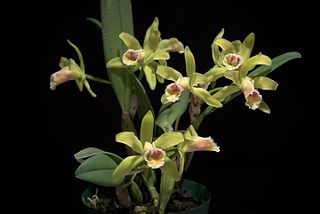
Cattleya luteola is a species of orchid, native to the lowland Amazon rainforest. It is present in Ecuador, Peru, Brazil and Bolivia.

Cattleya maxima is a species of orchid in subfamily Epidendroideae found from Ecuador to Peru.

Cattleya mossiae, commonly known as the Easter orchid, is a species of labiate Cattleya orchid. The white-flowered form is sometimes known as Cattleya wagneri. The diploid chromosome number of C. mossiae has been determined as 2n = 40. The haploid chromosome number has been determined as n = 20.

Cattleya schilleriana is a species of bifoliate Cattleya orchid.

Cattleya tenuis is a species of orchid. It shares the rarely used common name of Easter orchid with C. mossiae and C. schroederae.
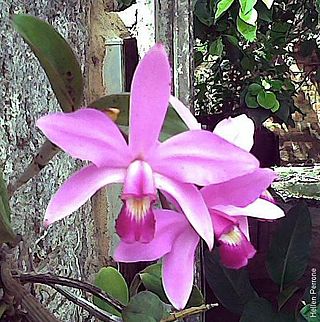
Cattleya violacea is a species of orchid native to the lowland rainforests of the Amazon and Orinoco river basins, being the most widespread of all Cattleya species in the wild. C. Violacea has been found throughout northern South America. Orchids of this species grow on trees along rivers, as they require heat and moisture year round.

Cattleya walkeriana, or Walker's cattleya, is a species of orchid. It differs from most species of Cattleya by having inflorescences which arise from the rhizome instead of from the apex of the pseudobulb. In its native habitat it grows as either an epiphyte or a lithophyte, sometimes in full sun, at elevations up to 2000 meters. Pseudobulbs are relatively short, bulbous or fusiform, with one or two ovate leaves at the apex. Inflorescence is one- or few-flowered, about 8" (20 cm) tall. Flowers are 4-5" (9-12 cm) across.

Alexander Theodorowicz Batalin, alternatively known as Alexandr Fedorovich Batalin, was a botanist from the Russian Empire. He was the Chief Botanist and Director of the Imperial Botanical Garden in St. Petersburg.

Cattleya elongata, the "cattleya with the elongated stalk", is an orchid species in the genus Cattleya endemic to the campo rupestre vegetation in northeastern Brazil.

Cattleya × elegans is a hybrid orchid in the subtribe Laeliinae. It is a pseudobulb epiphyte. Its formula hybridae is Cattleya purpurata Van den Berg (2008) × Cattleya tigrina A.Rich. (1848). It is found in South and South-East Brazil.

Cattleya mooreana is a species of orchid native to Peru. It is considered an endangered species since 1997 by the IUCN.
This page is based on this
Wikipedia article Text is available under the
CC BY-SA 4.0 license; additional terms may apply.
Images, videos and audio are available under their respective licenses.




















